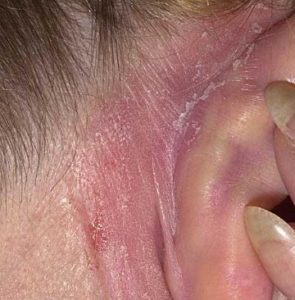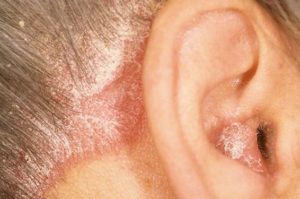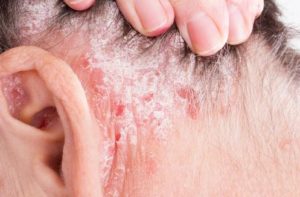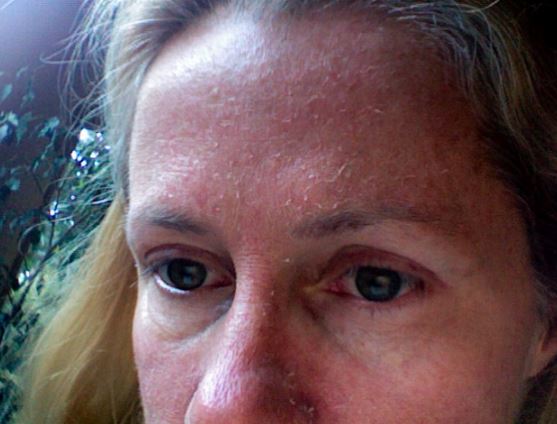Dry skin behind ear can be annoying and detrimental to your self-esteem. The common cause of dry, flaky and cracked skin is seborrheic dermatitis: a chronic relapsing but usually a mild dermatitis. This form of dermatitis affects the face, scalp and the torso. Dry skin is common in both adults and babies. Here is an insight on the causes, how to get rid and treat dry skin.
Dr. Sandra Lora Cremers defines dry skin as lacking adequate moisture. With dry skin, the skin feels tight and uncomfortable. According to her, dry skin behind ears and other parts of the body can be as a result of impaired lipid production within the skin leading to water loss that leaves your skin dehydrated. Dry skin is more prevalent in people with eczema and other skin condition.

Apart from eczema, other possible causes of dry skin will include low environmental humidity, use of harsh soap and skin care products, and medical or internal causes such as hypothyroidism. Hypothyroidism refers to an abnormally low activity of the thyroid glands, this condition results in retardation of growth and mental development in both children and adult when lefts untreated.
Dry skin behind ear lobe
Dry skin problems behind ear lobe, on the nose and on eyebrows can be quite consistent. Understanding the underlying cause of the dryness can be very important in trying to rid the skin of the dryness and treat the condition.
A common cause of dry skin is seborrheic dermatitis. It is a chronic intermittent rash typically affecting the face, ears, trunk and scalp. This form of dermatitis is believed to result from overactive sebaceous glands. Mild cases of this form of dermatitis can be considered harmless. In such case, treating the condition will involve the use of topical antifungal and steroid creams.
If the dry skin persists or you start experiencing unbearable symptoms such as itching, irritation and a burning sensation behind ear lobe, you need to see a professional health care provider as soon as possible.
When left untreated, dry skin behind ear lobe can spread to the outer part and the inner ear. When this is the case, then the underlying cause of the dryness is most likely to be eczema also known as atopic dermatitis. Dry skin caused by eczema can be managed and controlled with normal moisturizers creams and lotion. If they seem not to help, then you can try hydrocortisone cream.
If the dryness or other symptoms behind skin fails to respond to the creams and lotion, then you will need to have a professional skin care practitioner diagnose the condition. Not to scare you but skin cancer could be the possible cause of the dry skin behind the ear lobe. A common cause of skin cancer behind the ear is continued exposure to direct UV rays from the sun. Actinic keratosis is the name given to this condition.
Dry skin behind ears NHS
According to NHS, the common cause of dry skin is atopic eczema. They say atopic eczema or atopic dermatitis causes the skin to become red, itchy, dry and cracked. A form of dermatitis can occur on part of the body. The condition is, however, common in the hands, the inside of the, back of the knee face and the scalp.
Dry skin behind ear caused by atopic dermatitis will vary in severity from one person to the other. According to NHS, people with mild cases of eczema may only have small areas of dry skin that are occasionally itchy. For those with a more severe case of the condition, it can cause a widespread red, inflamed skin all over the body together with constant itching.
With dry skin behind the ear, scratching can disrupt your sleep, make the skin bleed and open your body for a possible secondary infection. When the area behind the ear is infected with eczema, it will temporarily turn darker or lighter after the condition improves.
Dry skin behind ears causes
The dry skin behind the ear or on the body is not considered a serious condition. Although dry skin can be annoying and cause a lot of discomforts, the condition often clears on its own with or without medical intervention. Understanding the underlying cause of dryness is the first step in attempting to treat the condition.
Here are some of the possible causes of dry skin behind the ear and other body parts.
Dry skin behind ears psoriasis
Psoriasis is a skin disease marked by redness, itching and scaly patches on the skin. The condition is also known to cause rashes and peeling of the skin. It is a chronic skin condition caused by the sped-up of skin production process.

The condition is not contagious as such you do not risk infecting others. The condition is believed to be triggered by stress, alcohol consumption, injury, infection and certain medication. Psoriasis has no cure, treatment will, however, aim at reducing skin inflammation and scale.
Could it be eczema?
Also known as atopic dermatitis, eczema could be the underlying cause of dryness behind the ear. Eczema is a medical condition in which patches of skin becomes rough and inflamed, with blisters that cause itching and bleeding. Eczema has no obvious cause.
Seborrheic dermatitis
This is another form of eczema. Also referred to as seborrheic eczema, it is a common skin condition that affects the scalp. The condition is known to cause scaly patches, red skin, and stubborn dandruff. The condition can also affect oil areas of the body such as the face, upper chest and the back.
Seborrheic dermatitis is a long-term treatment which requires repeated treatment for the symptoms to go away. Even with treatment, there are high chances of the symptoms recurring.
Sunburn
Overexposure to the sun without protective gears or applying sunscreen could lead to your skin becoming red, inflamed and in severe cases blistering and peeling of the skin. All this happens due to exposure to dangerous ultraviolet rays from the sun.
To protect against this, you need to always apply some sunscreen before going out.
Contact dermatitis behind ear
Contact dermatitis refers to an itchy rash on the skin caused when the skin comes in contact with reactive substances. The rush is therefore not contagious or life-threatening. It can, however, be very uncomfortable. Identify and avoid contact with the reacting substance to prevent the rash.
If you cannot identify the reacting substance, please seek medical attention.
Actinic keratosis
Actinic keratosis or simply solar burn or senile keratosis is a precancerous patch of thick, scaly, or crusty skin. This condition is fairly skinned people and those who are frequent in the sun. These growths will often form when the skin gets damaged by ultraviolet radiation from the sun.
- To protect against this condition, you will need to:
- Limit the extent of sun exposure
- Always make sure to use sun protection when going out
Cold or dry weather
Cold or dry weathers may rob your skin of the natural oils thus contributing to dry skin. This condition can cause your skin to become itchy, dry with red patches and to crack or flaky at times. In such conditions, you need to try not to shower for long hours using hot or steamy showers. Doing so could worsen the dry skin behind the ear and other body parts.
Dry cracked skin behind ears
Dry cracked or flaky skin behind the ear is in most cases a symptom of sunburn, psoriasis and other skin condition. At times, the skin behind the ear may get dry and flaky after a hot bath or shower. This is because hot substances on skin rid it of the natural oil. If hot shower is the cause of the dry skin, then you can prevent your skin from cracking by using a moisturizing soap or applying a post-shower moisturizing cream.
Seborrheic dermatitis is another possible caused of drying and cracking of the skin. This form of dermatitis is known to cause redness on the skin, itching, rash and white scales on the affected part of the skin. When affecting the scalp, seborrheic dermatitis is known as dandruff, it is common in other parts of the face and body including the folds around the nose, behind the ear, on the forehead eyebrows, and around the eyelids among other places.
To reduce scaling and cracking in the mentioned areas, you can use medicated shampoo twice or thrice a week. If the cracking continue within a week of using the medicated shampoo and moisturizing cream, then you will need to have the condition diagnosed. Treating the underlying cause of dry skin around the nose is key in stopping your skin from continuous cracking.
Dry skin behind ears baby
Dry skin also known as xerosis is common in both babies’ and adults. Dry skin can affect anyone regardless of age and gender. In most cases, dry skin is not considered harmless. The condition can, however, be uncomfortable and very annoying especially to children. With dry skin, lines and wrinkle could be manifested making you baby appear older than they are.
Apart from behind the ear, babies could experience dryness anywhere on the body. Dry skin can be felt on the arm, the face, and legs. A dry skin on children can be as a result of sunburn. Exposing your kid to direct sun rays without applying sunscreen around the ear and other body parts can cause your baby to be sunburned.
Dry skin behind ear caused by sunburn can be shown by the following symptoms, this is both in children and adults.
- Swelling and inflammation of the skin behind ear
- Severe headache and fatigue
- Abnormal high fever
- Redness or pinkness on skin (behind the ear)
- Itching pain and tenderness of the skin
- Small fluid filled painful blisters on skin
Dry flaky or scaly skin behind ears
A dry flaky or scaly skin behind ear occurs when the natural oils in skin dry up. Natural skin oil (sebum, which is an oily secretion of the sebaceous gland) is what keep your skin and the hair follicle moist. With an adequate amount of sebum on skin, your skin is able to maintain natural moisture, remaining hydrated to prevent dry skin.

The scaly, flaky or cracked skin behind the ear can be very painful and irritating. The common cause of flaky skin is seborrheic dermatitis. Other possible cause could be:
- Using harsh soaps and skin care products
- Allergic reaction to cosmetics and makeups
- Natural dry skin
- Fungal or yeast infection behind the ear
Cracking skin should not be left unattended, have a doctor prescribe the treatment as soon as possible. At home, you can manage the symptoms by washing your face with a medicated shampoo, a mild soap or applying natural remedies such as aloe Vera.
Dry itchy skin behind ears
Dry itchy skin is common not only behind the ear but all over the body. Dry skin can be caused by overexposure to sun, wind, and cold. In winters, when the temperatures drop, the humidity plunges, dry air leaves the skin parched. This is a common cause of dry and itchy skin.
Other possible causes would include:
- Taking long steam showers
- Continues use of moisture riding soaps and harsh cosmetics
- Aging, which is accompanied by hormone changes that cause the skin to become thin and parched.
Dry skin behind ears treatment
Treating dry skin behind the ear will depend on what the underlying cause of the dryness is. A mild case of dryness can be treated at home by applying essential oils such as coconut oil, tea tree oil, and olive oil. If the underlying cause of the dryness is not life threatening, then different over the counter topical creams and ointment can be used to relieve the symptoms and bring down the dry skin.
For dryness that persist for more than a week causing unbearable symptoms such as itching and inflammation behind the ear, then you will need to have a professional health care provider diagnose the condition.
A dermatologist is likely to prescribe the following depending on the extent of the infection causing dry skin.
- Inflammatory control medication, this can be informed of topical ointment, creams or skin care shampoos. The doctor may also prescribe a strength corticosteroid. This is common if the underlying cause of the dryness is seborrheic dermatitis.
- Antifungal medication pill is the other most likely treatment option your health care provider may prescribe for the dry skin. oral medication for skin condition are rarely recommended, this is because oral pill, for example, those used to treat seborrheic dermatitis are found to potentially cause an allergic reaction or other side effects.
- Together with the treatment for dryness, you doctor may prescribe a light therapy, photo-chemotherapy which involves exposing the affected skin to ultraviolet light may be used in treating dry skin behind the ear.
How to get rid of dry skin behind ears – Home Remedies
After understanding what the underlying cause of the dryness is, there are alternative therapies you can use to treat and relieve the symptoms accompanying dry skin behind the ear. Before attempting or enhancing your skin care routine, make sure to consult with your dermatologist of health care provider.
Some of the home therapies you might use to reduce the dryness and relieve symptoms such as rash, itching, irritation, swelling inflammation and burning sensation would include the following. Please seek medical attention if the remedies become reactive to your skin or the dryness persist.
Rub with garlic
If you thought garlic was only good for your food, then you thought wrong. Garlic is rich in medicinal properties that help heal skin and make it remain soft and smooth. Garlic is a potent antioxidant, which helps to regenerate skin and tissue making your skin appear soft and young.
For the case of dry skin behind ear:
- Stir garlic cloves with aloe Vera or olive oil
- Gently mix to attain a fine paste or mixture
- Wash your face and the affected area with a mild soap
- Apply the paste and leave it on
- Repeat this twice daily
Apply olive oil
Olive oil can be used as a skin moisturizers. It strong anti-itching properties can also be used to relieve the itching or continuous urge to scratch by simply applying few drops of this remedy on the affected part of the skin.
To use olive oil, direction of use:
- Gently rub some olive oil on the affected area
- Allow the oil to stay on for some minutes
- This way your skin will become softer making it easy to remove the flakes and crust caused by dry skin behind the ear.
Use apple cider vinegar
A dilute solution of apple cider vinegar is the other great home remedy you can use for the dry skin on the face. Gently apply the remedy on the affected area then gently massage the area, repeat this twice or thrice daily to reap the optical benefits.
Baking soda paste
A paste of baking soda can also be used to relieve the skin of the itching, cracking and irritation caused by dry skin behind the ear and other parts of the body.
Sources and references
- Doctor’s insight on dry skin behind ear: https://www.healthtap.com/topics/dry-flaky-skin-behind-ear
- Dry skin on my ear: https://www.healthtap.com/topics/dry-skin-behind-my-ear
- Seborrheic dermatitis: https://medlineplus.gov/ency/article/000963.htm
- Causes of skin rash behind the ears: http://www.healthhype.com/causes-of-skin-rash-behind-the-ears-with-pictures.html
- Itchy, crusty, scaly ear: https://www.drbaileyskincare.com/info/blog/itchy-crusty-scaly-ears-more-on-seborrheic-dermatitis
- Rash behind ear: http://www.doctorshealthpress.com/skin-care-articles/rash-behind-the-ear-5-causes-and-treatments
- Dry skin causes: https://healdove.com/disease-illness/Why-You-Have-Dry-Skin-Behind-Ears-Facts-Symptoms-Remedies-and-Treatments

